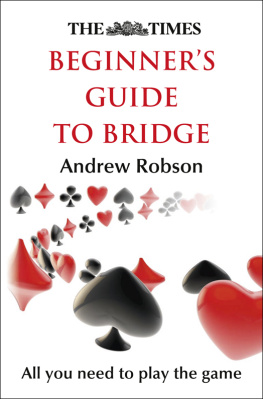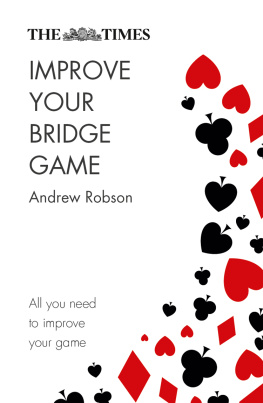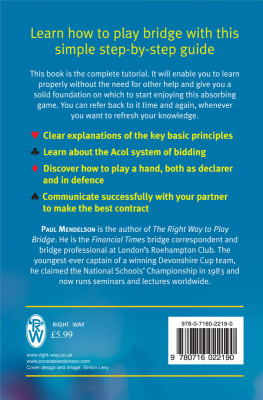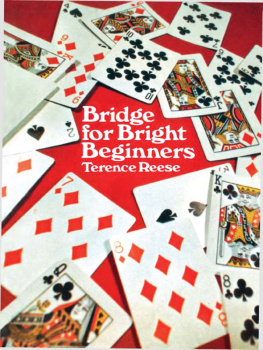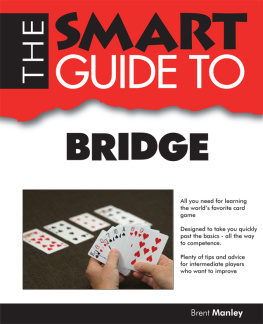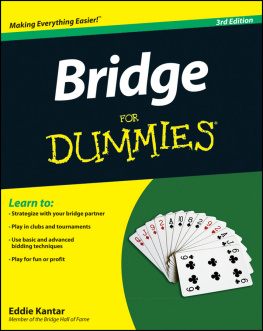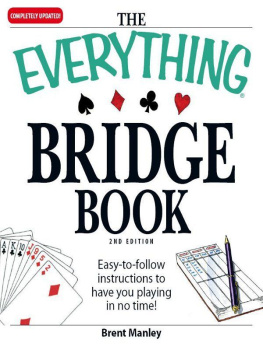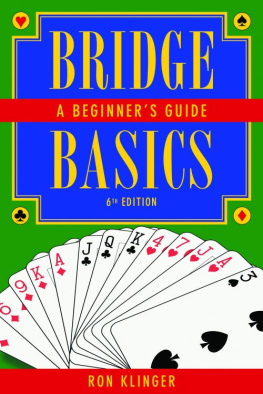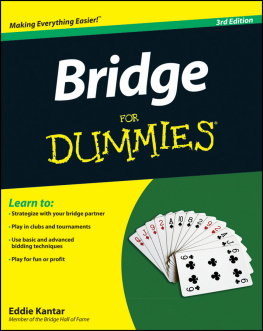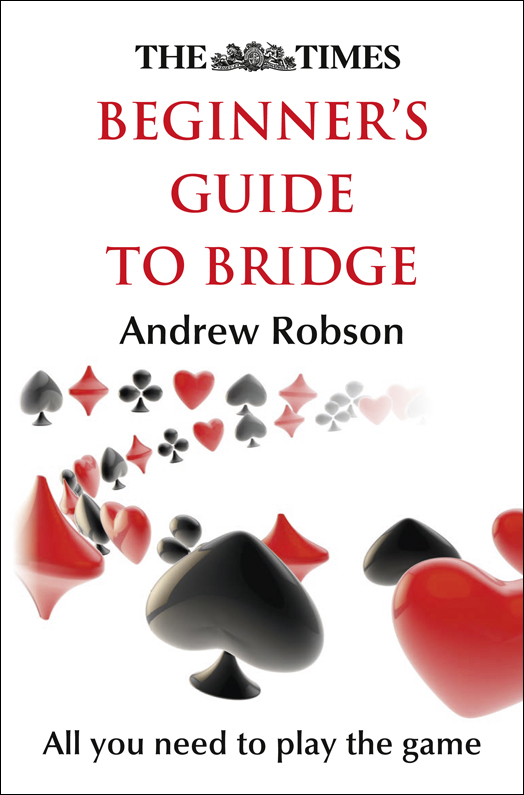Contents
To my mother and father, who got me started.
Andrew Robson, 2015
Welcome to bridge
Bridge is possibly the best game devised by mankind and certainly one of the most popular. But a word of warning: youll soon be hooked. Fortunately, this need not be expensive and will be good both for your brain and your social life.
First steps
This book will please complete beginners, as no assumption of prior knowledge has been made. Its also suitable for those who play social kitchen bridge and want to develop their game.
The first chapter (, and details of different types of bridge and bidding styles.
My suggestion is to read chapters 1 and 2, then try to get some practice even if its just dealing out cards by yourself (a very stimulating and productive thing to do). At this stage, although probably not the strongest player at the table, youll be able to play a perfectly adequate game of social bridge; best of all, youll be having fun. When youre ready, move on to as a reference when you want to know more about scoring.
must know
The best way to learn to play bridge is to set realistic goals, reinforce your knowledge and slowly build your skills. Most important of all is to enjoy playing.
A short history
A trick-taking game, bridge evolved from whist, which has been played for centuries. The first book devoted to whist, Edmond Hoyles Short Treatise, appeared in 1742 and became a bestseller.
No one knows the roots of the name bridge. It may have evolved from biritch, the name of a Russian game with similar rules, or possibly the Turkish term bir uc, meaning one-three as in one exposed hand and three concealed ones.
In 1903 British civil servants in India developed the practice of bidding for the privilege of naming the trump suit, thus introducing Auction bridge. Contract bridge, the universally played modern form, was only formally invented in 1925: not in a seedy back room, but on an American cruise ship under the guidance of Harold Vanderbilt. US marketer Ely Culbertson soon popularized the game, and by 1930 it was the society activity on both sides of the Atlantic. Since those first heady days, bridge has made front-page news when a famous British pair, Reese and Schapiro, were accused of cheating in 1965. It has attracted film stars Omar Sharif played at the top level and featured in many books, perhaps the most famous of all being Ian Flemings Moonraker. Bill Gates and Warren Buffett are keen bridge players, and if they give just a small fraction of their wealth back to the game, we can look forward to a very bright future, especially as bridge is now more widely accessible than ever via the internet.
Useful tip
Bridge is a ceaselessly fascinating and stimulating game. Start playing by partnering someone more experienced than you, who can help you get the most out of your play.
If you feel daunted by the complicated techniques and rules of bridge, just remember that its a game which can be enjoyed at any level. This chapter sets out the preliminary steps you need to make to have your first game of bridge.
The mechanics
Bridge is a partnership game. The bidding, the first phase of the game, establishes a target number of tricks to be made by each partnership. During the second phase, the partnership that wins the bidding tries to achieve their target number of tricks; the defending partnership tries to stop them.
Cards and ranking
Bridge is played with a standard pack of cards. The ace is the highest (or best) card of each suit the two is the lowest. The ranking of suits is in reverse alphabetical order, as shown in the diagram: clubs are ranked the lowest, then diamonds, hearts and spades the highest. Most social bridge, or Rubber Bridge (the different types of bridge are explained on ), is played with two packs of cards that are distinguishable by the colour (design) on the backs.

must know
Spades and hearts are the higher-ranking and higher-scoring suits, known as the majors; diamonds and clubs are the lower-ranking and lower-scoring suits, known as the minors.
Drawing for partners and dealer
Bridge is a game for four people (two partnerships) seated round a table. Their positions are often referred to as points of the compass: North, South, East and West. To decide on partners (if you dont wish to choose), and who deals first, each player draws a card, placing it face up on the table. Whoever draws the highest card deals first, chooses where to sit and ushers the player who draws the second highest card to be their partner. Partners sit opposite.

The position of partners at the table
must know
When drawing for partners or seats, the size of the card takes priority over the rank. Only when there are two same-size cards does the rank become relevant, for example the nine of hearts beats the nine of clubs.
Shuffling and dealing etiquette
The dealer chooses which of the two packs he wishes to deal. Before dealing commences, the opponent to the left of the dealer (LHO West in the following example) shuffles the chosen pack and places it on the dealers left; meanwhile the partner of the dealer (sitting opposite) shuffles the other pack and places it on their right. The dealer then picks up the shuffled pack on their left, shuffles it again (this is optional) and passes it to the opponent on their right (RHO East in the following example) to be cut. RHO cuts the pack by lifting (very approximately) half the cards, placing the top half on the table nearer the dealer and leaving the bottom half where it is. The cards are now ready to be dealt. The dealer takes the part of the pack furthest away from him and puts it on top of the closer part (known as completing the cut). He then picks up the pack (face down) and gives the top card (face down) to LHO, the next card to his partner opposite, the next to RHO, then one to himself, and so on in clockwise rotation, until all 52 cards have been dealt. The last card is always to the dealer.
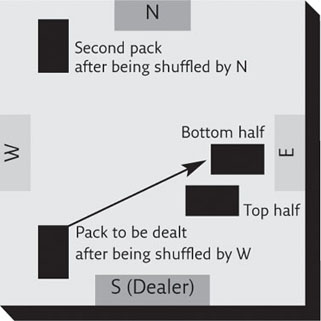
After the shuffle, showing South as the dealer; the pack is cut by East
When the next deal occurs (after all 52 cards have been played and 13 tricks won), this is done with the other pack. The new dealer is to the left of the previous dealer (in clockwise rotation). As before, the pack to be dealt is placed on the dealers left, shuffled by the person on their left, then cut towards the dealer by the person on their right.

The next deal: West is the new dealer and South cuts the cards
Useful tip
Bridge etiquette can seem tougher than the real game, but master it and youll earn the respect of other players.

